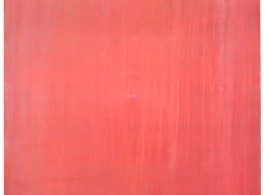Michel Mouffe (1957, Brussels) explores the foundations of painting by challenging its limits. His works are built up out of many thin coats of paint and glaze, creating translucent layers that veil each other and blend into an almost immaterial surface. Meanwhile he steps away from the flatness of the surface by implementing subtle protuberances emerging from behind the canvas. As space is marked and the two-dimensionality of the canvas is overcome, his works result in an experience of spatial relationships. The battle between line and colour has been put aside so that the two elements can work hand in hand. Subtlety of colour in Mouffe’s paintings is significant—it requires a slowed down gaze in order to see the vibrations of the gradual coloured surface. The lines break the monochrome surfaces as tools that open up, and thus liberate the paintings to give visual expression to the abstract thoughts and ideals of the artist. His works convey sensuality and thought, inviting the viewer to enter into a mutually constructive, psycho-corporeal dialogue, while addressing the limitless space of the painting with all of the viewer’s basic senses.
One of the paintings in this exhibition is titled, Shitao, and its name highlights the position of the painter as a philosopher, similar to when Leonardo Da Vinci wrote about painting as a spiritual thing, “cosa mentale”. Shitao was a Chinese painter, calligrapher and poet during the Qing Dynasty. Well known in the West for his treatise, Citations on Painting, Shitao noted that he soaked up the energy of his subjects as a way to restore breathing. Mouffe’s works likewise want to confirm their aura as a presence, as a humanity depicted by the abstract vibrations of the painting’s materiality. The manifestation of the canvas is a simple expression of the complexity it originated from.
Shitao, Chapter XV: “Anyone can paint, but no one has the Unique Pencil Stroke, because it is essential that painting originates from thought. Thought has thus to embrace the One because the heart has to create and be joyful. In these circumstances, painting can enter the essence of things all the way to the unmeasurable.”
The surfaces of Mouffe’s paintings have a rather skin-like feel due to his creation process. Skin—the human veil—is both a protective boundary and a sensitive opening: it subtly reveals a part of the hidden in a shiver or a sudden blush. In his essay, Le Moi-Peau (The Skin-Ego), philosopher Didier Anzieu metaphorically elaborates on the idea that identity takes shape through the pores of the skin (D. Anzieu, Le Moi-Peau, Paris, 1986). Skin carries imprints, affects and messages. In short, it communicates in the most fragile way. It happens unconsciously, yet is at the fundaments of who we are. Likewise, the protrusions rising from behind the canvas make the skin somewhat flawed, organic, and seemingly lived in.
Mouffe’s works are painted paradoxes. Like skin—at once a boundary and an intermediate—they linger between presence and absence, inside and outside. The paintings are not representations of a certain concrete reality, nor does their meaning reside in what is directly shown. Their being cannot be systematically deduced from external factors, but is rather to be found in what is veiled.
People are permeable and in-between in very much the same way as the surface of Mouffe’s sculptured paintings, lingering between presence and absence, inside and outside. The artist creates breathing bodies that invite viewers to engage in a back and forth dialogue between reflection and absorption. The pulsating screens offer pure space on which memories and desires can be projected. His particular use of colour, lines and relief functions as a signpost or a guide, but is, of course, not the goal itself. In other words, the monochrome panels represent the sensuality of emotional space, while the lines and bumps function as the roads that lead us there. It is the whole of this that guides the viewer on its way into the unfathomable space behind and within the glazed surface.



